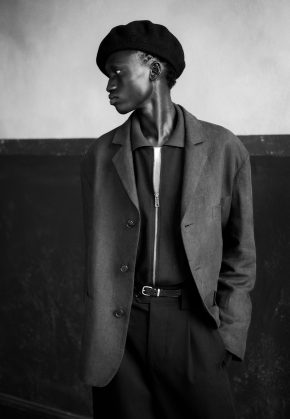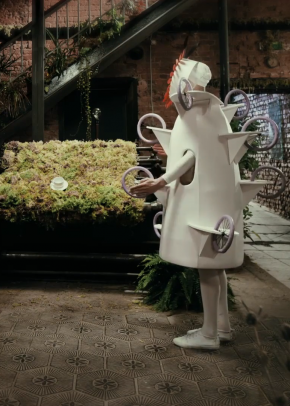Yanaijima (Yamaguchi, Japan)

In pursuit of the “lost” fabric that once coexisted with peoples’ everyday lives.
The city of Yanai, which is located at the base of the Murotsu Peninsula in eastern Yamaguchi Prefecture, was commonly referred to as “Yanaitsu” from before the Edo period, and has flourished as a prominent commercial port and as a key region for marine traffic. The production of cotton flourished in this area during the early Edo years, and was the birthplace of the “watagae” business, a system in which cotton merchants exchanged products and fees for the labor of artisans after providing them with raw materials.
The quality of Yanai cotton cloth was guaranteed due to the seal stamping system of official approval introduced by the Iwakuni Domain in Horeki 10 (1760), which eventually led to it being sent to other domains via the Yanai River, which flows through the center of the city. The production of striped cotton cloth began in Man’en 1 (1860) when artisans began weaving hand-spun cotton dyed with true indigo, and the durable fabric suited for farming became known throughout the country as “Yanai-jima” (or Yanai stripes).

Production of Yanai-jima continued into the Meiji period with the introduction of the “Takahata” loom, but as society began to modernize, hand-woven indigo dyed striped cotton cloth grew obsolete, and demand dropped rapidly between the end of the Meiji period and the Taisho period.
Although Yanai-jima became established as a traditional textile craft due to the fact that the fabric was used for everyday life, the production of Yanai-jima almost completely disappeared, and eventually became known as a “lost” fabric.

Years passed as Yanai-jima fabric was almost completely forgotten. However, nearly 30 years ago, it reappeared. It all started when a Takahata loom was discovered in an old house in the nearby region and was presented to the city as a gift.
The loom, which had the words, “Meiji 34” engraved onto it, was actually used by the household when weaving the Yanai-jima fabric under the seal stamping system of official approval. The discovery of the once-forgotten Takahata loom increased the interest to revive production of the traditional fabric, and with the help of local volunteers, the “Yanai-jima Preservation Society” was formed.



Nonetheless, reviving a culture that was once completely lost is not an easy task. Tadao Ishida, chairman of the “Yanai-jima Preservation Society”, who worked tirelessly for the revival and preservation of the fabric since the beginning of the movement, helped repair broken looms and traveled to various regions of Shikoku and Hiroshima to learn about the traditional weaving technique.
“There are not so many authentic Yanai-jima kimonos left in spite of the fact that they were so abundant at the time. Unlike high-end fabrics, Yanai-jima fabrics were used to make everyday clothing, so it was easier for people to throw them away. Today, there is only a collection of sample books of the fabrics that were used during the end of the Meiji period, and many of them were made using twin yarn (made by twisting single pieces of yarn together) for both vertical and horizontal directions. You can see that there were actually a wide variety of striped patterns.”



The existence of Yanai-jima was gradually acknowledged thanks to these steady efforts, and today there are over 80 members in the group, with approximately 20 weavers among them.
Even today, the principles of “cotton yarn, vertical stripes, and indigo dye” are preserved, and in addition to reproducing traditional Yanai-jima fabric, the group is also working on creating a new style of Yanai-jima by adding bright colors using vegetable dyes.


In the Kanaya district, once the center of commerce of Yanai where rows of traditional houses with white mud walls still remain standing today, you will find the Yanai Nishigura, which was built during the end of the Taisho period and used as a soy sauce warehouse. Several Takahata looms were installed inside the warehouse, which was completely renovated as a gallery and hands-on workshop where visitors can experience Yanai-jima loom weaving and goldfish-shaped lantern making, another local traditional folk art.
These lanterns were originally painted with the dye used for Yanai-jima fabrics. While catering to the rural lifestyle, this fabric was deeply rooted in the culture so even after nearly being lost forever, it was revived literally by the hand (hand spinning), to connect its memory to future generations.


YANAI NISHIKURA MUSEUM
3700-8 YANAI, YANAI CITY, YAMAGUCHI 742-0021
0820 23 2490
Museum Hours : 9:00-17:00
Closed : Every Tuesday (except for National Holidays on Tuesday, in which case the museum is closed on the following day), New Year’s holiday
Survey, defined as: to examine or inspect. In these features, we will be reporting on things, people, places, or cultures that inspire us in our daily work of making products.
edit & text: Kosuke Ide
photo: Keisuke Fukamizu

























Comments